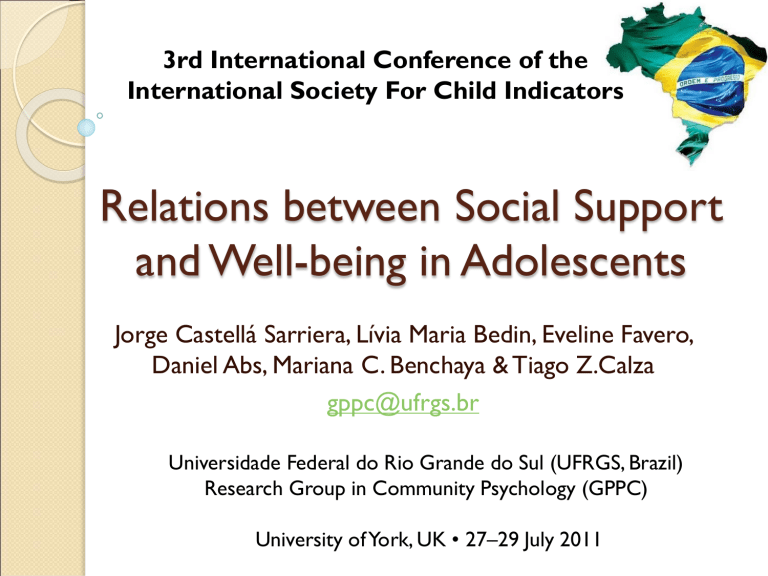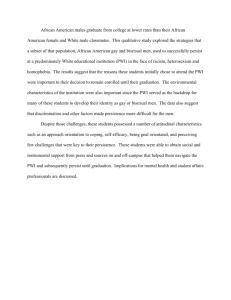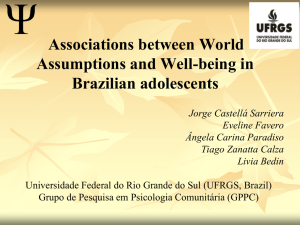Relations between Social Support, Life Satisfaction and Well

3rd International Conference of the
International Society For Child Indicators
Relations between Social Support and Well-being in Adolescents
Jorge Castellá Sarriera, Lívia Maria Bedin, Eveline Favero,
Daniel Abs, Mariana C. Benchaya & Tiago Z.Calza
gppc@ufrgs.br
Universidade Federal do Rio Grande do Sul (UFRGS, Brazil)
Research Group in Community Psychology (GPPC)
University of York, UK • 27–29 July 2011
Introduction
Social support:
Is based on the social support concept proposed by Cobb
(1976), and after used by Vaux (1988), who defines it as the information that makes someone believe that is cared and loved, esteemed and valued.
Information of support can be transmitted through intimate situations involving mutual trust and it’s often referred to as emotional support.
Positive relationship with support persons, such as parents, contribute to the improvement of the adolescents’ well-being
(Ben-Zur, 2003).
In the presence of social support there is a better well-being perception (Petito & Cummins, 2000).
Introduction
Personal Well-Being
◦ It is conceptualized as feeling good or not, along the life cycle overall, not in occasional moments of life.
◦ It can be understood as a reciprocal relationship between internal aspects (psychological) and its external interactions with other people and the context (psychosocial).
Casas (2010); Cummins, Eckersley, Pallant, Van Vugt & Misajon (2003)
Objective
This paper aimed to verify possible differences between personal well-being and social support in adolescents considering age and gender and to explore relations between this variables in the sample.
Method
Sample:
1,589 students (548 boys and 1,081 girls) from five cities in the state of Rio Grande do
Sul (the capital state city and four other smaller cities of countryside).
Ages ranged between 12 and 16 years old, with a mean of 14.13 (SD = 1.26).
Instruments:
Social Support Appraisals Scale (SSA, Vaux et al.,
1986)
SSA measures the adolescents’ perception of the social support provided by their family, friends and others in general. In this study, only items related to the family and friends subscales were used.
It consists of 12 agree-disagree items ranging from 0 to
10
In this study, the SSA’s Cronbach’s Alpha was 0.86.
Instruments
Personal Well-being Index (PWI)
Assessment of people’s satisfaction with general aspects of life (Cummins, Eckersley, Pallant, Van Vugt,
& Misajon, 2003).
The PWI-7 consists of the following seven items:
Satisfaction with health, living standards, what one has achieved in life, security, the groups of people one is part of, security about the future and the relationships one has with others.
In this study, the PWI-7’s Cronbach’s Alpha was 0.78.
Procedure
◦ The participants were contacted through public and private schools belonging to the cities in the sample.
◦ The selected schools were randomized from a list provided by the Department of Education of the State of
Rio Grande do Sul.
◦ The final survey participants were volunteer students who returned a term of free and clear consent signed by them and by their parents or guardians.
◦ The questionnaires were applied collectively in a room provided by each school.
◦ All ethical requirements for research with human beings were followed.
Results
Average and standard deviation for the Personal Well-being
Index by age and gender groups.
Age
12
13
14
15
16
Total
Well Being Index
Male
80.48 (14.09)
84.51 (09.59)
83.21 (11.19)
80.90 (10.62)
82.70 (10.18)
82.56 (10.96)
Female
85.43 (10.70)
81.99 (12.27)
81.36 (12.25)
79.59 (12.36)
79.41 (12.09)
81.17 (12.20)
Total
83.69 (12.19)
82.98 (11.34)
81.95 (11.94)
80.04 (11.79)
80.51 (11.56)
81.65 (11.80)
Results
Interactions between age and gender and PWI.
Results
Average and standard deviation for the SSA by age and gender groups.
SSA Average
Age
12
13
14
15
16
Total
Male Female Total
7.79 (2.06) 8.52 (1.33) 8.25 (1.67)
8.32 (1.28) 8.42 (1.34) 8.38 (1.31)
8.07 (1.36) 8.27 (1.47) 8.21 (1.44)
8.07 (1.25) 8.18 (1.56) 8.14 (1.46)
8.26 (1.39) 8.23 (1.39) 8.24 (1.39)
8.13 (1.43) 8.30 (1.44) 8.24 (1.44)
Results
Interactions between age and gender for:
Family Social Support
Friends Social Support
Results
Analysis of variance of PWI and Friends and Family Social Support
Source
Age
Gender
Age * Gender
Dependent
Variables
Sum of
Squares df
Mean
Square
F
PWI 1850.547
4 462.637
3.387
Friends SS 19.843
4 4.961
1.609
Family SS
PWI
15.692
197.550
4
1
3.923
197.550
1.449
1.446
Friends SS 80.579
Family SS 1.194
1
1
80.579
26.141
1.194
.441
PWI 1845.755
4 461.439
3.378
Friends SS 36.436
4 9.109
2.955
Family SS 14.841
4 3.710
1.371
Sig.
.000
.507
.009
.019
.242
.009
.169
.215
.229
Results
Pearson correlations were performed and Significant correlations were found between the Personal Well-Being
Index with all items of perceived friends’ and family’s social support (p < 0.001),
It was performed a Confirmatory Factorial Analysis of the scales SSA and PWI with the entire sample. Adjusts presented satisfactory results according to the literature
(Batista-Foguet & Coenders, 2000; Byrne, 2001),
A final model was built using the Personal Well-Being Index as a factor related to social support.
Results
Final model of relation between
Social Support and PWI
Results
Fit statistics for the factor structure a model
Factor Model for PWI
Factor Model for SSA
MultiGroup SEM Final
Model: Unconstrained factor loadings
MultiGroup SEM Final
Model: Constrained factor loadings
Qui-
Square
28.1
274.21
DF
11
46
Sig.
P < 0.001
P < 0.001
RMSEA (CI)
0.031 (0.017 – 0.046)
0.056 (0.050 – 0.062)
CFI
0.993
0.978
3559.31
1505 P < 0.001
0.021 (0.020 – 0.022) 0.927
3674.91
1541 P < 0.001
0.021 (0.020 – 0.022) 0.924
Discussion
The perception of social support in adolescence can vary with time, since changes in relationship groups, such as parents and friends, often take place.
Family and Friend’s influence has fundamental importance in this stage of life due to the processes of independence and autonomy, especially in regards to emotional support, loyalty, understanding and intimacy
(Antunes & Fontaine, 2005).
Also, trust of family and friends, both included in this research, are important to aid the development of the adolescent’s independence and autonomy.
Discussion
Family and friends still have a central role in the adolescent’s development (Pratta & Santos, 2007) and interventions that promote and strengthen the social support from these groups are important.
The support system may also be develop beyond family and friends, and may constitute an important source of esteem, care, respect and affiliation to a group (López-
Cabanas & Chacón, 1997; Gracia, 1998).
Contributions
To verify the relationship between perceived support in adolescents’ close relationships and their well-being in a theoretical model that can be applied to different age groups of teenagers, regardless of gender.
This proper fit of the model is important for future research on the relationships and contexts of adolescents and their direct or indirect impact on their quality of life.
Despite the good model fitting, it is considered that cultural differences can have an effect on the results and that more research can be undertaken in this respect, since these relations tend to be established differently in other cultures.
References
Antunes, C., & Fountaine, A. M. (2005). Percepção de Apoio Social na Adolescência: Análise
Fatorial Confirmatória da Escala Social Support Appraisals. Paidéia, 15(32), 355-366.
Retrieved from http://www.scielo.br/pdf/paideia/v15n32/05.pdf
.
Batista-Foguet, J. M. & Coenders, G. (2000) . Modelos de Ecuaciones Estructurales. Madrid: La
Muralla.
Ben-Zur, H. (2003). Happy adolescents: The link between subjective well-being, internal resources, and parental factors. Journal of Youth & Adolescence, 32(2), 67-79. doi: 0047-
2891/03/0400-0067/0.
Byrne, B.M. (2001). Structural Equation Modeling With AMOS: Basic Concepts, Applications, and
Programming. New Jersey: LEA.
Casas, F. (2010). El bienestar personal: Su investigación en la infancia y la adolescencia.
Encuentros en Psicología Social, 5(1), 85-101.
Campbell, A., Converse, P. E., & Rogers, W. L. (1976). The quality of American life: Perceptions,
evaluations, and satisfactions. Nueva York. Russell Sage.
Cobb, S. (1976). Social support as a moderator of life stress. Psychosomatic Medicine, 38(5),
300-314. Retrieved from http://www.psychosomaticmedicine.org/ cgi/reprint/38/5/300 .
Cummins, R.A., Eckersley, R. Pallant, J. Van Vugt, J, & Misajon, R. (2003). Developing a national index of subjective wellbeing: The Australian Unity Wellbeing Index. Social
Indicators Research, 64, 159-190.
References
Diener, E., & Diener, M. (1995). Cross-cultural correlates of life satisfaction and self-esteem,
Journal of Personality and Social Psychology, 68(4), 653–663. doi: 10.1007/978-90-481-2352-
0_4.
Gracia, E. (1998). El apoyo social en la intervención comunitaria. Barcelona: Paidós.
Hair, J. F., Anderson, R. E., Tatham, R. L., & Black, W. C. (2005). Análise Multivariada de dados.
Porto Alegre: Bookman.
Kline, R. B. (1991). Latent Variable Path Analysis in Clinical Research: A Beginner’s Tour
Guide. Journal of Clinical Psychology, 47(4), 471-484.
López-Cabanas, M. & Chacón, F. (1997). Apoyo social, redes sociales e grupos de autoayuda.
In López-Cabanas, M. & Chacón, F. (Eds.), Intervención psicosocial y servicios sociales. Un
enfoque participativo (pp. 183-215). Madrid: Síntesis Psicológica.
Petito, F., Cummins, R.A. (2000). Quality of life in adolescence: the role of perceived control, parenting style and social support. Behavior Change, 17(3), 196-207.
Pratta; & Santos. (2007). Família e Adolescência: A Influência do Contexto Familiar no
Desenvolvimento Psicológico de seus Membros. Psicologia em Estudo, 12(2), 247-256.
Vaux,A. (1988). Social Support:Theory, research, and intervention. NY: Praeger.
Vaux, A., & Wood, J. (1987). Social support resources, behavior, and appraisals: A path analysis. Social Behavior and Personality, 15(1), 105-109.
Vaux, A., Phillips, J., Thomson, B., Holly, L., Williams, D. & Stewart, D. (1986). The social support perceptions (SSA) Scale: studies of reliability and validity. American Journal of
Community Psychology, 14, 195-220.
http://
www.ufrgs.br/gppc
Email: gppc@ufrgs.br
3rd International Conference of the
International Society For Child Indicators
Relations between Social Support and Well-being in Adolescents
Jorge Castellá Sarriera, Lívia Maria Bedin, Eveline Favero,
Daniel Abs, Mariana C. Benchaya & Tiago Z.Calza
gppc@ufrgs.br
Universidade Federal do Rio Grande do Sul (UFRGS, Brazil)
Grupo de Pesquisa em Psicologia Comunitária (GPPC)
University of York, UK • 27–29 July 2011






